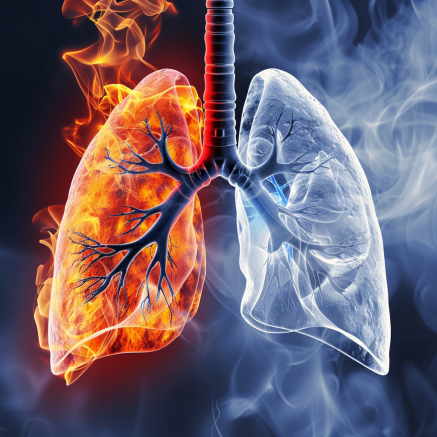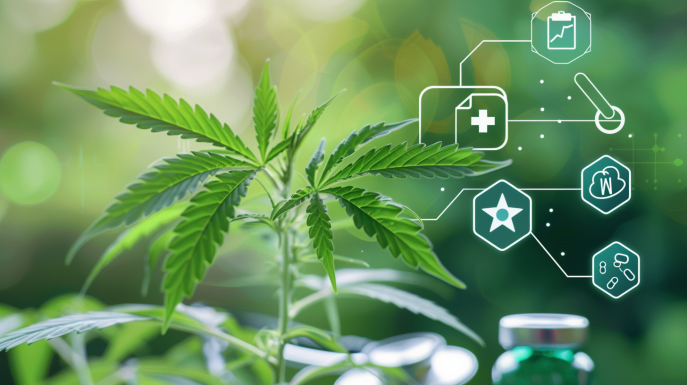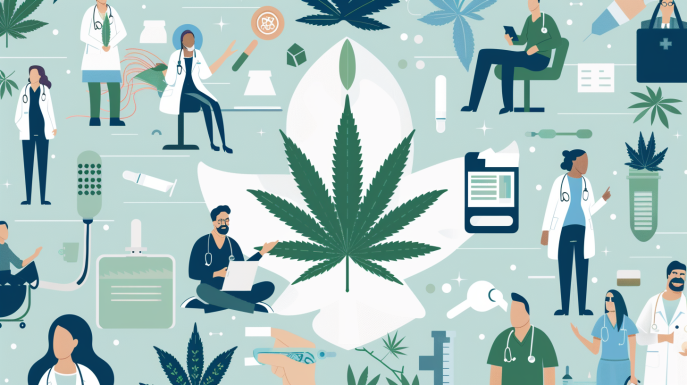Robust dialogues and accurate information about medicinal and recreational cannabis are crucial to dispelling myths, knocking down stigmas, and promoting safe usage.
As we wade through the top 10 most widespread misconceptions about medicinal and recreational cannabis, we aim to encourage informed choices, dismantle stigma, and stimulate discussions grounded on empirical evidence.
This way, our journey towards safer cannabis usage and improved public policies becomes enlightened.
Dr. Peter Grinspoon, a renowned primary care doctor specializing in cannabis treatments at Massachusetts General Hospital and a respected teacher at Harvard Medical School, provides valuable insights countering popular myths about cannabis and its health impacts for chronic ailments.
Let’s dive right in.
1. Cannabis is a Panacea for All Ills
Reality: Cannabis does hold potential therapeutic promise for specific chronic diseases but is far from being a cure-all. Its efficacy varies considerably across illnesses and individuals.
Scientific investigations are underway to explore the full spectrum of its medical uses.
Cannabis—often referred to as marijuana or weed—is a plant that houses more than a hundred distinct chemical compounds known as cannabinoids.
The most famous ones are tetrahydrocannabinol (THC) and cannabidiol (CBD). Many patients swear by CBD’s benefits including easing insomnia, anxiety, spasticity, and discomfort.
Medicinal marijuana is typically used for pain management—particularly chronic pain—as well as a muscle relaxant. Other reported applications include relief for glaucoma, weight loss, nausea, PTSD in military veterans, HIV-related pain and wasting syndrome, irritable bowel syndrome (IBS), Crohn’s disease, epilepsy, seizures, and multiple sclerosis (MS).
Initial research hints at the following potential benefits of cannabinoids:
- Alleviating anxiety
- Reducing pain and inflammation
- Managing nausea related to chemotherapy
- Inhibiting the growth of cancer cells
- Easing muscle stiffness in MS
- Boosting appetite in cancer and AIDS patients
In 2018, the FDA gave the green light to Epidiolex—a cannabidiol—for treating seizures linked with Lennox-Gastaut syndrome and Dravet syndrome.
The FDA also approved two synthetic cannabinoid medicines, dronabinol (Marinol, Syndros) and nabilone (Cesamet), for controlling nausea and vomiting induced by chemotherapy.
2. The Harmful Impact of Smoking Cannabis is Equal to Tobacco
Reality: While smoking any substance can harm your health, research indicates that puffing cannabis is generally less detrimental than tobacco smoking.
However, it’s worth noting that cannabis smoke can still have negative impacts on your respiratory system.
Even though a 2008 BMJ study suggested a 1:2.5–5 dose equivalence between cannabis joints and tobacco cigarettes in terms of adverse lung function effects, a 2021 article in Pulmonary Therapy stated that it’s unclear how cannabis smoke exposure equates to cigarette smoke.

The CDC reveals that “Cigarette smoking is responsible for more than 480,000 deaths per year in the United States, including over 41,000 deaths resulting from secondhand smoke exposure.”
That’s roughly one in five deaths annually or 1,300 deaths daily. On average, smokers live 10 years less compared to non-smokers.
It’s possible to overdose on cannabis.
Reality: Per the National Institute on Drug Abuse (NIDA), a federal government research body, no adult death has been solely linked to cannabis. Nevertheless, large dosage can cause discomfort and temporary side effects.
“Death from cannabis overdose is unheard of,” says Grinspoon in his conversation with LifeSciencesIntelligence.
“But I can vouch from personal experience—and so can many others—that excessive cannabis can induce a very nasty and uncomfortable episode.”
In LaPlace, Louisiana, Dr. Christy Montegut, the 70-year-old coroner of St. John the Baptist Parish, concluded that a 39-year-old woman passed away in February 2019 due to excessive THC levels—the main psychoactive component in cannabis.
This verdict has, however, raised eyebrows among experts and researchers since no documented adult fatalities have been linked directly to THC. Notably, the THC content in the woman’s blood measured low at 8.4 ng/mL.
Occasional incidents related to cannabis-induced deaths may make headlines nationwide, but the evidence for lethal toxicity is not convincing.
Experts argue that the possibility of dying purely from THC exposure is extremely low and should not be a trigger for policy alterations.
In 2022, a 30-year-old Virginia mother was taken into custody after her 4-year-old son died from consuming what she assumed was a CBD gummy—it later tested positive for THC. Despite the medical examiner attributing the death to THC toxicity, experts cast doubts on the direct correlation between THC and fatality.

While cannabis is unlikely to cause death directly, accidents or injuries under its influence can be fatal. Experts warn that kids consuming high THC levels could become drowsy and risk choking if they vomit.
4. Does Cannabis Contribute to Lung Cancer?
Look, let’s not beat around the joint. The roots of the connection between sparking up a blaze and lung cancer are not as obvious as its cousin, tobacco.
Even though heavy, chronic puffing on a joint might go hand in hand with respiratory troubles, there’s no clear-cut evidence right now suggesting that it raises the risk of lung cancer.
“Inhaling cannabis has never — and believe me, they’ve tried — been proven to link with chronic obstructive pulmonary disease (COPD), emphysema, or lung cancer,” says Dr. Ganja. “Although, it’s established that it can cause acute bronchitis in your lungs.
But remember this: physicians are not in favour of smoking because of the by-products of combustion like tar, benzene, and polycyclic, aromatic hydrocarbons.”
A study published in the 2021 Pulmonary Therapy journal found that toking cannabis via combustion leads to considerable respiratory effects such as changes in lung function and symptoms.
Yet, the real link between inhaling cannabis smoke and lung cancer remains up in smoke.
5. Is Marijuana Highly Addictive?
Truth be told, while some people might get caught up in cannabis, it doesn’t get everyone hooked. The likelihood of addiction depends on various factors — your genes, how much you puff and pass, and individual susceptibility.
“The addiction rates for cannabis have been exaggeratedly blown up by psychiatrists during the war on drugs,” says Dr. Ganja. “They estimate that between 9% and 33% of adults using cannabis get hooked on it, but the real figure is likely between 2–5%.”
A study in the American Journal of Psychiatry reveals that the occurrence of a 12-month and lifetime marijuana disorder was at 2.5% and 6.3%, respectively.
Individuals with this disorder had frequent marijuana use, with an average of 225.3 and 274.2 days per year for 12-month and lifetime disorder cases, respectively.
The chances of the disorder were higher among males, Native Americans, unmarried individuals, those with low incomes, and young adults.
What’s more, it was connected with other substance, affective, anxiety, and personality disorders. Health impairment was linked to a 12-month marijuana use disorder. As the severity of the condition increased, so did the associations.
However, among those with a lifetime marijuana use disorder, only 24.3% sought out 12-step programs or professional treatment.
“Sure, people can get hooked on cannabis but they don’t typically harm themselves or break into pharmacies like those with opiate addictions,” says Dr. Ganja.
“The abuse potential is moderately low for cannabis. Undoubtedly it’s nowhere near as high as alcohol or tobacco — both of which are completely legal. Plus, you don’t see people dying from cannabis addiction.”
6. Does Chronic Cannabis Use Impair Memory?
Many research studies have put out the roach on the myth that cannabis causes long-term memory loss. The facts point out that while cannabis might affect short-term memory, mostly because of THC, there’s almost no evidence proving that it leads to long-lasting or significant memory impairment.
Long-term use of cannabis during adolescence has been linked to changes in the hippocampus and potential effects on memory processes.
But, the impact it has on memory is not as drastic as some think, and it doesn’t result in everlasting memory loss.
For adults, the evidence suggests that cannabis mainly affects short-term memory.
Any potential surge on long-term memory is nominal and not substantial enough to trigger long-term memory loss.
The notion that using cannabis inevitably causes long-term memory loss is baseless. The research we have supports a more detailed understanding of its effects on memory functions.
Dr. Ganja supports the idea that cannabis is a safer option than certain pharmaceutical drugs like Ambien, known to cause memory loss and dissociative events.
He thinks that using a small amount of CBD with THC in edibles or tinctures for sleep is a low-risk choice.
However, the limited knowledge and involvement of doctors deter the potential harm reduction that cannabis could offer if used more broadly.
7. Cannabis Paves the Way for Harder Drugs
Fact Check: The theory that consuming cannabis inevitably spirals into harder drug use has been proven unfounded. While there might be a connection between initial cannabis consumption and later drug use, it’s important to remember that correlation doesn’t equal causation.
Multiple elements like personal predispositions and societal influences play a role in patterns of drug use.
As illustrated by a 2023 study published in Psychological Medicine, researchers scrutinized over 4,000 twins from Colorado and Minnesota.
They found no correlation between the legalization of cannabis and increases in cognitive, psychological, social, relationship, or financial problems.

Despite fears that cannabis could serve as a stepping stone to more dangerous substances, the study observed no changes in illegal drug use following its legalization.
Considering the results of this particular study, there is no substantial evidence to uphold the belief that cannabis serves as a ‘gateway’ drug.
8. All Types of Cannabis Produce the Same Effects
Truth Bomb: Cannabis comes in varied strains and forms each containing distinct combinations of cannabinoids and other compounds, which can induce diverse health effects.
To exemplify, CBD (cannabidiol) is non-intoxicating and may hold therapeutic potential, whereas THC (delta-9-tetrahydrocannabinol) triggers the psychoactive effects of cannabis.
Nope, not all forms of cannabis result in the same impact. Cannabis is a plant enriched with various chemical compounds—out of which two primary classes significantly influence its effects: cannabinoids and terpenes.
Cannabinoids
The most famous cannabinoids include tetrahydrocannabinol (THC) and cannabidiol (CBD), although cannabis contains over 100 other identified varieties. THC is the psychoactive compound inducing the “high” feeling associated with marijuana use, and it can lead to euphoria, altered perception, relaxation, and increased appetite.
Conversely, CBD is non-psychoactive and is widely related to potential therapeutic effects such as pain relief, reduced anxiety, and anti-inflammatory properties.
Different strains and forms of cannabis can have varied ratios of THC to CBD, triggering diverse effects on users. For instance, some strains might be high in THC and low in CBD, leading to a more intense psychoactive experience. At the same time, others may have balanced ratios or high CBD content for a gentler, non-intoxicating effect.
Terpenes
Terpenes are aromatic compounds present in cannabis and other plants. They contribute to the unique smell and taste of different strains and play a part in influencing the overall effects of cannabis.
Some terpenes may foster relaxation, while others might boost alertness or modify how cannabinoids interact with the body.
“Terpenes are what make cannabis flavorful and aromatic: some induce alertness or sleepiness,” commented Grinspoon.
This mix of cannabinoids and terpenes in a specific strain leads to what is known as the “entourage effect”—the concept that various compounds in cannabis collaboratively work, enhancing each other’s effects.
The effects of cannabis can further be influenced by elements such as the method of consumption (smoking, vaping, edibles, etc.), dosage, individual tolerance levels, and even the user’s mental state and surroundings at the time.
It’s critical to understand that the effects of cannabis can differ greatly among individuals— what one person experiences may drastically differ from another. Furthermore, laws and regulations surrounding cannabis can vary by region, so it’s vital to stay informed about local regulations and make responsible decisions regarding its usage.
9. Is Weed a Trigger for Psychosis?
It’s time to put an end to this debate once and for all: while cannabis can amplify the effects of pre-existing psychotic conditions in individuals prone to them, it does not spontaneously generate psychosis.
Investigating deeper, we find that a heightened risk of earlier onset of such disorders is correlated with cannabis use, especially for those people whose family members have had a history of such conditions.
In fact, consumption of cannabis in larger concentrations can lead to temporary psychotic symptoms. And yes, going through these episodes might be tied to a higher likelihood of eventually developing a chronic psychotic disorder.
The role played by genetic factors cannot be overlooked either, implying that cannabis consumption can potentially trigger the early onset of psychosis in individuals who have genetic predispositions.
These symptoms might get aggravated in victims already suffering from psychosis. Additionally, some studies have suggested links between cannabis use and other mental health issues, including self-harm and suicidal tendencies.
However, the full extent of these relationships is yet to be revealed as they are influenced by various factors like frequency of use, potency, and individual characteristics.
Hence, a more detailed research trajectory is required to pin down causative factors and vulnerabilities.
Procuring Education Over Prohibition
Grinspoon suggests that the focus should be on education around informed usage rather than outright prohibition, particularly for individuals transitioning into emerging adulthood.
For instance, individuals with personal or family history of psychosis are recommended to refrain from using cannabis. It’s essential to note that the nexus between cannabis and psychosis is intricate and those claims that cannabis surges schizophrenia rates remain unproven.
According to Grinspoon, “Despite a substantial rise in global cannabis users since the 1950s, schizophrenia prevalence remains stable at around 1%, implying that it’s highly unlikely for cannabis to be a fundamental cause.”
However, it’s important to mention that, while cannabis itself may not induce an increase in schizophrenia cases, it can potentially spark an earlier onset of the condition among those genetically predisposed to it.
An early onset of psychosis can heavily affect a young adult’s life, as they could potentially lose five crucial years that could’ve been spent acquiring essential life skills, self-care, and societal functioning. Consequently, an early onset can worsen the long-term prognosis compared to a late onset.
The Multitudes of Cannabis Consumption – Beyond Smoking
Busting another myth here: Smoking isn’t the only way to consume cannabis. Though it’s definitely one way, cannabis experts suggest oral ingestion over smoking due to its milder effects, controlled dosing, and evasion of respiratory complications.
The choice on how to consume should be made based on personal health considerations and preferences. Remember, being informed and responsible about cannabis use always guarantees a safer experience.
The methods to consume cannabis are versatile. Here’s a list of at least 12 standard consumption methods:
- Smoking (joints or pipes)
- Vaporizing (warming up plant material or concentrates)
- Edibles (food-based products like gummies, brownies, and candies)
- Tinctures (sublingual extracts)
- Topical applications (creams, salves, and lotions)
- Dabbing (inhaling concentrated extracts)
- Beverages (like teas and sodas)
- Capsules
- Suppositories (for rectal or vaginal administration)
- Sublingual strips (dissolving strips to be placed under the tongue)
- Patches (adhesive patches for skin application)
- Sprays (for quick oral consumption)
Grinspoon also brings to light a remarkable alternative for those seeking immediate relief: the dry herb vaporizer. This could especially be a game changer for patients undergoing chemotherapy treatments who cannot afford the wait time of edibles when they’re hit by a wave of nausea.
A dry herb vaporizer works by heating the herb to roughly 400 degrees – a temperature that facilitates cannabinoids extraction without the detrimental effects of smoking or combustion.
This method is significantly less damaging to the lungs and health in general.
Engaging with healthcare professionals and relying on scientific findings is crucial for obtaining accurate and up-to-date information about the potential benefits and risks of cannabis for specific chronic diseases.
It’s recommended that patients have an open discussion with their doctors about medical marijuana use. Doctors should maintain an educated, open-minded, and non-judgmental stance regarding patients’ usage of medical marijuana, thus fostering trust within the doctor-patient relationship, emphasizes Grinspoon.
No, while cannabis has therapeutic potential for certain conditions, it is not a cure-all and its effectiveness varies.
Research suggests that smoking cannabis is generally less harmful than tobacco, but it can still negatively impact respiratory health.
No adult deaths have been solely attributed to cannabis overdose, though high doses can cause temporary discomfort.
There is no clear evidence linking cannabis smoking to lung cancer, unlike tobacco, which is a known cause.
Cannabis addiction rates are lower than those for substances like alcohol and tobacco, but some people may develop a dependency.
Cannabis can affect short-term memory, especially due to THC, but there is little evidence of long-term memory impairment









